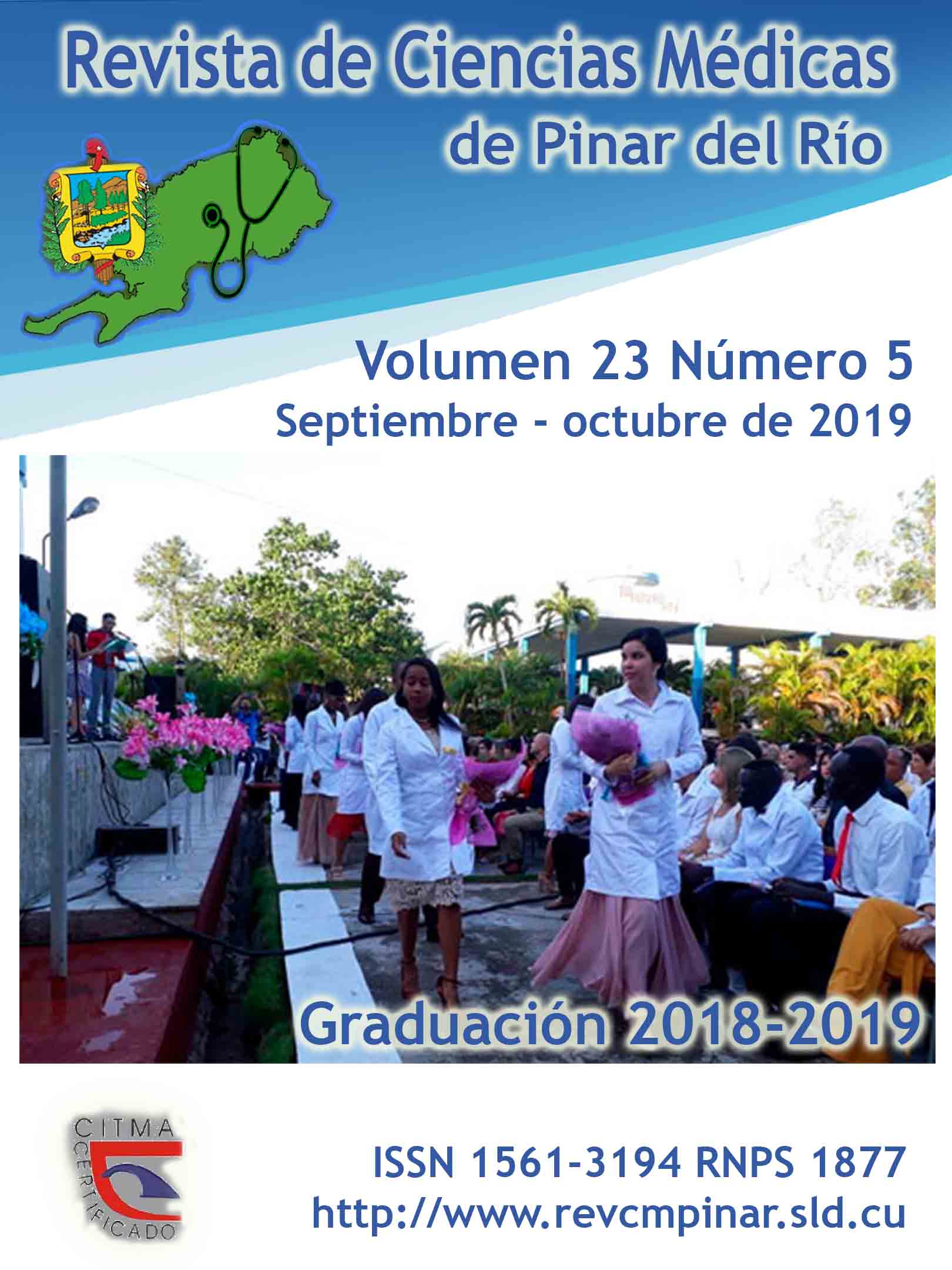Proposal of an educational intervention based on child abuse in a special education institution
Keywords:
EDUCATION, PROFESSIONAL, SPECIAL, DISABLED CHILDREN, ADOLESCENT, KNOWLEDGE.Abstract
Introduction: child abuse is a universal and multicausal problem involving bio-psycho-social factors. The health sector and the educators of special education must have adequate information on issues such as monitoring and prevention of child abuse.
Objective: to design an educational intervention based on child abuse.
Methods: an applied research was carried out with proposals for intervention in two stages, the first describing and the second presenting the proposal, which was conducted at Conrado Benítez García Special Education Institution in Los Palacios municipality, Pinar del Río province, during the period of October-December 2018. Target Group: 52 workers. Sample: 27 people connected to the education and health of these students.
Results: professional women with a work experience between 10 and 20 years predominated; the total of those surveyed recognized having received some information on child abuse; the main sources were: seminars and postgraduate courses (37 %); 45.4 % knew some forms of child abuse, the syndromes of sudden death and shaken child were only known by doctors; the capacity for prevention was perceived by all individuals included in the sample.
Conclusions: as part of the inclusive actions of promotion, prevention and health education, an educational intervention on child abuse was designed aimed at professionals connected to the health and education of children with intellectual disabilities.
Downloads
References
1. López R. Educación de alumnos con necesidades educativas especiales. Fundamentos y actualidad. La Habana: Ed. Pueblo y Educación; 2010. p. 45-7.
2. Acosta Moya EC, Valdivia Álvarez I, Yvonne Giletta P. Conocimientos sobre maltrato infantil en adolescentes maltratados y padres o tutores. Rev Cubana Pediatr [Internet]. 2017 Jun [citado 31/07/2019]; 89(2): [aprox. 8p.]. Disponible en: http://scielo.sld.cu/scielo.php?script=sci_arttext&pid=S0034-75312017000200008&lng=es.
3. Borges Rodríguez S, Orosco Delgado M. Pedagogía y Educación Especial en el debate actual de la atención educativa y los procesos inclusivos. En: Actualidad de la atención educativa a los niños y adolescentes con necesidades educativas especiales: cap. La Habana: Ed. Pueblo y Educación; 2014. p. 1-16.
4. Algunos factores que influyen en el conocimiento real del maltrato infantil. Temas de interés Editorial: Las Nuevas Tecnologías de la Información y la Comunicación en la prevención del maltrato infantil. PREVEMI: prevención del maltrato infantil; 2010 [citado 30/10/2018]. Disponible en: http://www.sld.cu/sitios/prevemi
5. Declaración de la AMM (Asociación Médica Mundial) sobre el Maltrato y Abandono Del niño y la niña. 57e Asamblea General de la AMM, Pilanesberg, Sudáfrica; Oct 2006.
6. Asociación Medica Mundial. Declaración de Helsinski de la AMM-Principios éticos para las investigaciones médicas en seres humanos. [Internet] Asociación Médica Mundial; 2013. [citado 30/10/2018]. Disponible en: https://www.wma.net/es/policies-post/declaracion-de-helsinki-de-la-amm-principios-eticos-para-las-investigaciones-medicas-en-seres-humanos/
7. Suárez Guzmán N, Bermúdez Díaz I, Díaz Senra W, López Rodríguez JJ, Moreno Hernández LA, Delgado Pérez IE. Conocimientos sobre maltrato infantil en madres de escolares. Rev Cubana Med Gen Integr [Internet]. 2016 Mar [citado 31/07/2019]; 32(1). Disponible en: http://scielo.sld.cu/scielo.php?script=sci_arttext&pid=S0864-21252016000100007&lng=es.
8. Pérez Cabrera CL, Peña Cruz G, Cabrera Reyes LC. Maltrato infantil y la atención en el nivel primario de salud. Rev Hum Med [Internet]. 2017 Ago [citado 31/07/2019]; 17(2): [aprox. 20p.]. Disponible en: http://scielo.sld.cu/scielo.php?script=sci_arttext&pid=S1727-81202017000200012&lng=es.
9. Cantalapiedra Torres A. ¿Accidente o maltrato? Una pregunta de actualidad. Rev.Med.Electrón. [Internet]. 2016 Dic [citado 07/08/2019]; 38(6): [aprox. 10p.]. Disponible en: http://scielo.sld.cu/scielo.php?script=sci_arttext&pid=S1684-18242016000600006&lng=es
10. Priegue Caamaño D, Cambeiro Lourido M. Los conocimientos acerca del maltrato infantil de los futuros profesionales de la educación: un estudio exploratorio. Revista Complutense De Educación [Internet]. 2016 Dic [citado 07/08/2019]; 27(3): [aprox. 13p.]. Disponible en: http://dx.doi.org/10.5209/rev_RCED.2016.v27.n3.47152
11. Alonso Gutiérrez G, Martínez Gómez C, Peralta Benítez H, Ballbé Valdés A, García Pérez R, Giance Paz L. Modelo de la dinámica del proceso de promoción de salud frente al maltrato infantil. MediCiego [Internet]. 2018 [citado 07/08/2019]; 24(2): [aprox. 15 p.]. Disponible en: http://www.revmediciego.sld.cu/index.php/mediciego/article/view/931
12. Pineda Pérez ElJ, Gutiérrez Baró E. Intervención educativa sobre el maltrato infantil aplicada a trabajadoras de la educación especial. Rev Cubana Med Gen Integr [Internet]. 2017 Mar [citado 07/08/2019]; 33(1): [aprox. 13p.]. Disponible en: http://scielo.sld.cu/scielo.php?script=sci_arttext&pid=S0864-21252017000100003&lng=es
13. Fleitas Ruiz R. La relación familia, escuela y comunidad a través de la educación como función de la sociedad. En: Rivero Baxter Y, Esquerra Quintana G, Mellado Pérez BY. La educación del siglo XXI desde una perspectiva social, aportes del pensamiento sociológico contemporáneo y cubano. La Habana: Editorial Universitaria Félix Varela; 2016. p. 211-252.
14. Martínez Negrín Y. Maltrato infantil: ¿un problema de género?. Rev Cubana Med Gen Integr [Internet]. 2016 Mar [citado 07/08/2019]; 32(1). Disponible en: http://scielo.sld.cu/scielo.php?script=sci_arttext&pid=S0864-21252016000100006&lng=es.
15. Lugones Botell M, Ramírez Bermúdez M. Bullying: aspectos históricos, culturales y sus consecuencias para la salud. Rev Cubana Med Gen Integr [Internet]. 2017 Mar [citado 07/08/2019]; 33(1): [aprox. 10p.]. Disponible en: http://scielo.sld.cu/scielo.php?script=sci_arttext&pid=S0864-21252017000100014&lng=es.
Published
How to Cite
Issue
Section
License
Authors who have publications with this journal agree to the following terms: Authors will retain their copyrights and grant the journal the right of first publication of their work, which will be publication of their work, which will be simultaneously subject to the Creative Commons Attribution License (CC-BY-NC 4.0) that allows third parties to share the work as long as its author and first publication in this journal are indicated.
Authors may adopt other non-exclusive license agreements for distribution of the published version of the work (e.g.: deposit it in an institutional telematic archive or publish it in a volume). Likewise, and according to the recommendations of the Medical Sciences Editorial (ECIMED), authors must declare in each article their contribution according to the CRediT taxonomy (contributor roles). This taxonomy includes 14 roles, which can be used to represent the tasks typically performed by contributors in scientific academic production. It should be consulted in monograph) whenever initial publication in this journal is indicated. Authors are allowed and encouraged to disseminate their work through the Internet (e.g., in institutional telematic archives or on their web page) before and during the submission process, which may produce interesting exchanges and increase citations of the published work. (See The effect of open access). https://casrai.org/credit/



